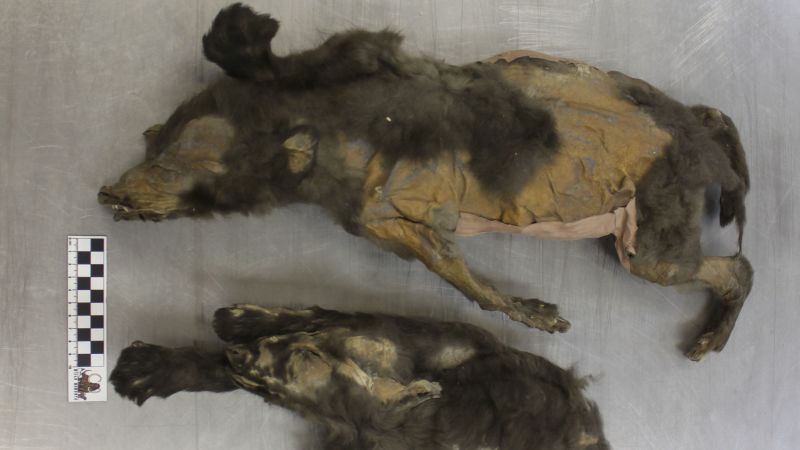Recent discoveries of two remarkably preserved ice age “puppies” in Northern Siberia have prompted researchers to reconsider their initial identification as domesticated dogs. Known as the “Tumat Puppies,” these specimens, still clad in fur and encased in ice for millennia, reveal remnants of their last meals, which included woolly rhinoceros meat and wagtail feathers.
Initially believed to be early tamed dogs or wolves cohabiting with humans, the pups were uncovered near burned mammoth bones, suggesting human activity in the area. However, genetic analyses of the pups’ stomach contents and chemical compositions of their bones have led researchers to conclude that they are actually 2-month-old wolf cubs, with no signs of direct interaction with humans, according to a study published in Quaternary Research.
The two mummified cubs, presumed sisters, likely perished suddenly after their den collapsed approximately 14,000 years ago, possibly due to a landslide. This sudden collapse allowed researchers to glean insights into the everyday lives of ice age animals, revealing that their diet was comparable to that of contemporary wolves.
“It was incredible to find two sisters from this era so well preserved, but even more incredible that we can now tell so much of their story, down to the last meal that they ate,” said lead study author Anne Kathrine Wiborg Runge, formerly a doctoral student at the University of York and the University of Copenhagen. “Whilst many will be disappointed that these animals are almost certainly wolves and not early domesticated dogs, they have helped us get closer to understanding the environment at the time, how these animals lived, and how remarkably similar wolves from more than 14,000 years ago are to modern day wolves.”
The Tumat Puppies were found separately at the Syalakh site, located about 25 miles from the village of Tumat—one in 2011 and the other in 2015. Both cubs are dated to be between 14,046 and 14,965 years old. Study coauthor Dr. Nathan Wales, a senior lecturer in archaeology at the University of York, noted that the discovery of two such well-preserved siblings within such a short timeframe is highly unusual.
Similar to today’s wolves, the pups consumed a mix of meat and plant material. Evidence of woolly rhinoceros skin in one pup’s stomach suggests the cubs were not only actively fed but were also in a moment of respite in their den when they met their demise. The rhino skin, with its light fur, indicates it may have originated from a juvenile, aligning with previous findings of young woolly rhinoceroses found in permafrost.
“The hunting of an animal as large as a woolly rhinoceros, even a baby, suggests that these wolves may have been larger than modern-day wolves,” Wales explained.
Alongside their meat-based diet, the pups were likely still nursing. However, no evidence of mammoth consumption was found in their remains, suggesting that they weren’t directly fed by humans at the butchering site nearby. Wales speculated that it is more likely adult wolves provided a juvenile woolly rhino to the cubs.
The study emphasizes the significant challenges in tracing the domestication of dogs, often considered humanity’s first domesticated animal. Researchers propose that some wolves may have scavenged near human settlements, leading to a potential symbiotic relationship over generations, while other theories suggest humans may have selectively raised wolves.
Further analyses indicated that the Tumat Puppies likely belonged to an extinct wolf population that did not contribute genetically to modern dogs. Wales stated, “Today, litters are often larger than two, and it is possible that the Tumat Puppies had siblings that escaped the same fate.”
Dr. Linus Girdland-Flink from the University of Aberdeen, who studies ancient wolves and dogs, highlighted the complexities in categorizing remains as either wolves or early domesticated dogs. He noted the fragmented archaeological record and emphasized the need for a combination of evidence from multiple disciplines to draw any conclusions about the origins of domestic dogs.
Ultimately, the Tumat Puppies reveal invaluable information about the life and diet of ice age wolves, presenting new angles in understanding the evolution of species and their relationships with early humans.

